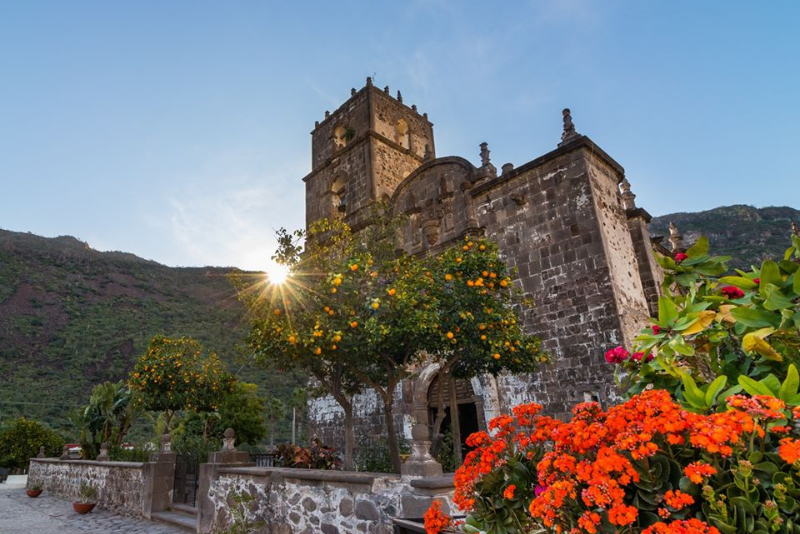Published on 17/04/2025
The Secret Garden of Calm: Discover the Endemic Flora of Loreto and Baja California Sur

"There’s a stillness in nature that fills the soul with peace."
Loreto, in Baja California Sur, is the kind of place that invites you to slow down and see the world differently. Beyond the turquoise waters and the islands of Loreto Bay National Park, this corner of Mexico is a haven of endemic flora—thriving at the magical meeting point between desert and sea.

Endemic Flora of Loreto: Wild Beauty Between Deserts and Mountains
Loreto’s plant life has learned to survive where few would expect anything to grow. Adapted to scorching sun, limited water, and salty soil, these species are small masterpieces of natural engineering.
•Cardón (Pachycereus pringlei): Considered the world’s largest cactus, it can reach up to 19 meters tall, store over a ton of water, and live for as long as 300 years.
•Cholla and sweet pitaya: Their spiny branches conceal beautiful flowers and edible fruit.
•Loreto biznaga: A rounded cactus that bursts into vibrant blooms in spring and plays a key role for native pollinators like bees.
Fun fact: Like Arizona’s saguaro, the cardón provides shelter for birds such as owls and woodpeckers, which nest inside its soft trunk.

Nature in Baja California Sur: Where Desert Meets Sea
One of Loreto’s most captivating qualities is how the vegetation transforms as it approaches the coastline. Coastal flora brings the landscape to life with vibrant contrast.
•Mangroves (red, white, and black): These filter the water, stabilize the coastline, and serve as natural nurseries for fish and crustaceans.
•Salicornia and romerillo: Salt-loving plants that thrive in saline environments, painting the shores with shades of red and green.
•Islands of Loreto Bay National Park: Their unique microclimate supports plant species adapted to wind, salt, and sun.
Traveler tip: Visit the islands by kayak or guided tour to explore the coastal flora up close. Bring binoculars—some birds and flowers are best spotted from a distance.

Mexican Desert Flora: Remarkable Survivors of the Arid Climate
In Loreto, every plant seems to tell a story of endurance. Many bloom after brief rains, transforming the scenery in just a few days.
•Palo Adán (Fouquieria diguetii): A spiny shrub with red flowers that attract hummingbirds. Its sap is used in traditional medicine.
•Torote (Bursera microphylla): Known for its reddish bark that peels like paper and releases a resinous fragrance.
•Palo fierro (Olneya tesota): Sacred to Indigenous communities, this tree has wood so dense it sinks in water.
Fun fact: The palo fierro blooms in purple during spring and is one of the first signs of seasonal change in the desert.

Biodiversity in Loreto: A Paradise for Ecotourism in Mexico
Loreto is perfect for travelers who want to reconnect with nature at their own pace. Ecotourism here is a way of life—one that honors and protects the environment. If you’re visiting for the first time, these spots are great places to discover the region’s flora:
•Tabor Canyon: Perfect for sunrise hikes among cacti and rocky landscapes.
•Coronado Island: Coastal plants, seabirds, and cacti just steps from the sea.
•Loreto Malecón: From this quiet waterfront walkway, you can spot mangroves, birds, and stunning sunsets.
Traveler tip: Wear closed-toe shoes, and don’t forget water and sun protection. The plants are beautiful, but many are spiny or grow in rocky areas.

Loreto, the Natural Escape You’ve Been Looking For
Loreto isn’t just a beach destination—it’s a secret garden where endemic flora speaks of adaptation, beauty, and balance. Here, nature appears unfiltered: wild, vibrant, and deeply peaceful.
If you’re drawn to authentic landscapes, peaceful walks, and the thrill of discovering unique species, Loreto in Baja California Sur will inspire you. Travel mindfully, and let the calm of the desert bloom within you too.

Oliver Heldt
Linda L
Mike B

Goyotraveler
R0n69

Jassyho
Coastal682943
Freddyloan
Malu Yunez
 The arrival of the Blue Giant to the waters of the Sea of Cortez
The arrival of the Blue Giant to the waters of the Sea of Cortez
 The blue whale in Loreto, BCS
The blue whale in Loreto, BCS
 Loreto 21k Half Marathon
Loreto 21k Half Marathon




